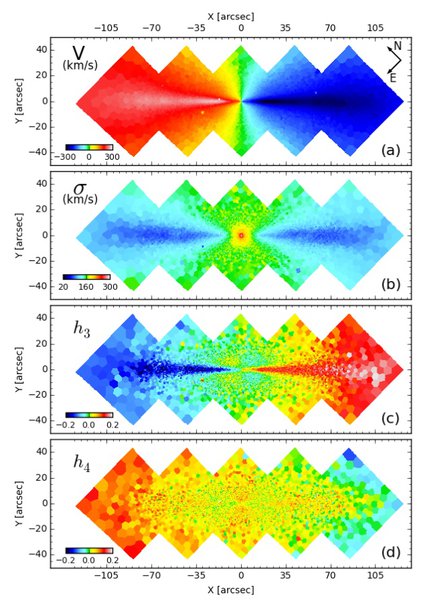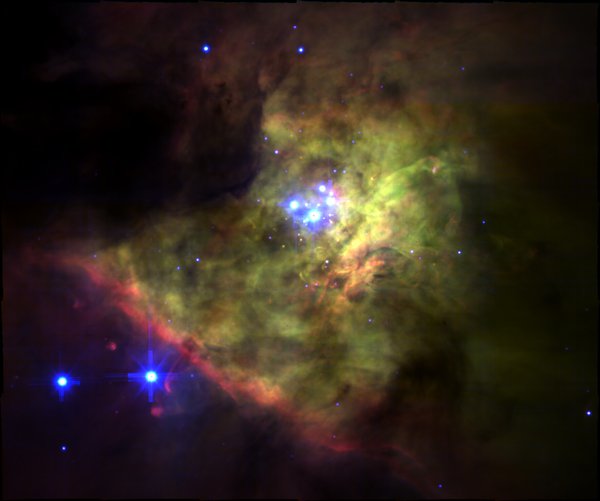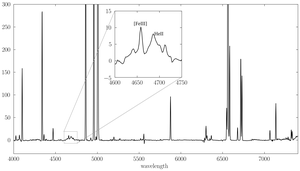Spatially Resolved Spectroscopic Diagnostic of Galaxies
Structure, Kinematics and Dynamics of Galaxies

Stellar kinematic maps of galaxy NGC3115, observed with MUSE using a sequence of 5 pointings (hence the "saw-edge" look). They show from top to bottom: the mean velocity (ordered rotation), the velocity dispersion (random motions), and the higher order moments of the line-of-sight velocity distribution, parametrised with Gauss-Hermite moments h3 and h4, which present the asymmetric and symmetric deviations from a pure Gaussian distribution of velocities. The stellar kinematics show that this galaxy consists of a thin and fast rotating disc, embedded in a slower rotating spheroid, as well as that this galaxy might still host a weak bar, not visible in the morphology, but only in the correlation between the h3 moment and the mean velocity in the central 15". Credit: Image is take from Guerou et al. (2016).
Our group studies the morphological components of galaxies, from nuclear clusters in dwarf galaxies, disks, bars and bulges in spiral galaxies, to galaxy cores in the most massive elliptical galaxies, in order to understand how galaxies have formed and evolved over time. Besides studying their stellar populations, we also study kinematics of gas and stars, which we use to investigate the internal structure of galaxies, as well as evidence of processes that shaped them. The kinematic maps of NGC 3115 (see figure on the right) show for example how much ordered motions (rotation) and random motions (dispersion) are present in the stars. These maps contain many clues on the structure of galaxies, not necessarily visible on the images. They can be analysed with tools such as kinemetry to reveal their secrets. They provide a robust measure of the stellar angular momentum, an important constraint to theoretical models of galaxy evolution. Finally, such kinematic maps provide inputs for further studies of internal structure of galaxies using dynamical models.
Observed motions of gas and stars in galaxies can be very complex, indicating that there are multiple components which can rotate around different symmetry axes or even in opposite directions. Such co-existing structures could be in unstable configurations which change over time, or they can form dynamically stable long-lived structures. Our group investigates them by using various dynamical modelling techniques, such as Jeans models, and axisymmetric and triaxial Schwarzschild models. Our efforts focus on constraining the intrinsic shapes of galaxies, the mass distribution of gas, stars and dark matter in galaxies, and measuring the masses of supermassive black holes residing in the galactic nuclei.
Nearby objects allow us to investigate the structure and kinematics in great detail. Obtaining stellar kinematics from distant galaxies is much more challenging. This is the frontier that will be explored with future facilities, such as MOSAIC on the Extremely Large Telescope, but we have already started investigating the evolution of stellar angular momentum and kinematics of galaxies living in the Universe at only half its current age or less.
Our group is leading or involved in a number of surveys of large numbers of galaxies, of different types, across various environments and reaching into distant Universe (ATLAS3D, CALIFA, SAMI, M3G) using the most advanced instruments (SAURON, MUSE, PMAS) for mapping kinematics of galaxies.
HII regions and young stellar populations

The Orion Nebula (M42) observed with MUSE. This color image was created by integrating the spectrum at the blue end (for the blue channel), the ionized gas emission around Hβ and [OIII] (green), and around Hα and [NII] (red).
Credit: Peter Weilbacher (AIP)With a distance of about 440 pc the Orion Nebula (M 42) is one of the closest star-forming regions, the one that we can investigate with the best spatial resolution. The MUSE mosaic of the brightest part of the nebula, the "Huygens region" (about 0.76pc x 0.63pc in the image), enables a detailed study of the physical properties of the ionized gas surrounding the bright young stars. Among other things, we were able to derive maps of extinction towards the regions emitting in hydrogen, as well as densities (from lines of sulfur and chlorine) and temperatures (from nitrogen and sulfur). The MUSE cube of the Orion Nebula is publicly available at MUSE M42 page.

Spectrum of an HII Region in NGC 3353 with a Wolf-Rayet feature.
Credit: Anika Beer (AIP)Although rare, massive stars dominate the feedback to the interstellar medium (ISM) in star forming environments due to their stellar winds and finally via supernova explosions. Even when they can not be resolved into single stars like in the Milky Way, we can still study them through integrated spectroscopy of their surrounding, so called HII regions. Using the integral field spectroscopy survey CALIFA containing spectra of more than 20,000 HII regions we systematically study the number of massive stars, especially O stars and Wolf-Rayet (WR) stars, and compare these results to stellar population models. The goal is to improve our knowledge of the high-mass end of the initial mass function (IMF).